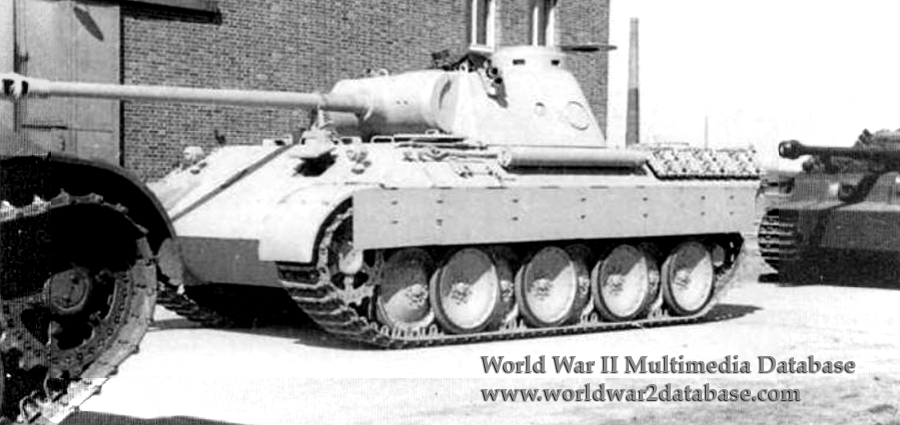| Panzerkampfwagen V Panther ausf D at the Henschel und Sohn factory. Note the Panzerkampfwagen VI Tiger I behind the Panther; it is still in red oxide primer. 850 Panther ausf Ds were made by Maschinenfabrik Augsburg-Nurnberg Aktiengesellschaft (MAN AG, a public company) Daimler-Benz, Maschinenfabrik Niedersachsen-Hannover (MNH) and Henschel. This early production model has smoke grenade launchers on the turret and Schurzen (Skirting) – armor plates protecting the drive train – to protect against Soviet anti-tank rifles. Fierce debate raged among German munitions leaders over the Panther. The tank was rushed in development on the orders of Karl-Otto Saur (February 16, 1902 – July 28, 1966) the State Secretary for Armaments and War Production. As Minister for Armaments and War Production Albert Speer (March 19, 1905 – September 1, 1981), Saur had personally promised Hitler that the Panther would be ready for action in July 1943, in time for Operation Zitadelle, the German offensive at Kursk. However, General Heinz Guderian (June 17, 1888 – May 14, 1954) was appointed Generalinspektur der Panzertruppen (Inspector-General of the Armoured Troops) on March 1, 1943 and refused to certify the Panther for combat. Guderian peferred to focus production on the Panzer IV and Sturmgeschutz III, because they were already in production and he recognized that quantity was more important. Now several panzer programs would be competing for scarce resources. The new tank that had reliability problems and the tendency to burst into flame during operations (a rubber seal for watertight integrity caused the engine to overheat and catch fire). Saur overruled him, and the Panther, with many teething troubles, were sent into combat at Kursk. Within a few days, only forty-three of the 250 Panther ausf Ds were still operational; most were in need of repair. As the Panthers rolled off the assembly line, the design was continually upgraded. The differences between late production ausf D and early production ausf A are so slight, identification can be difficult. The Panther ausf A worked out the tank‘s problems, and the Panther was soon a potent weapon and much feared on both the Western and Eastern Fronts. | |
| Image Filename | wwii0146.jpg |
| Image Size | 224.99 KB |
| Image Dimensions | 900 x 425 |
| Photographer | Unknown |
| Photographer Title | |
| Caption Author | Jason McDonald |
| Date Photographed | May 01, 1943 |
| Location | Henschel und Sohn Tank Works |
| City | Kassel |
| State or Province | Hessen |
| Country | Germany |
| Archive | |
| Record Number | |
| Status | Caption ©2007, ©2024 MFA Productions LLC Please Do Not Duplicate or Distribute Without Permission |

Author of the World War II Multimedia Database

